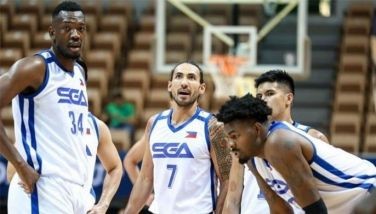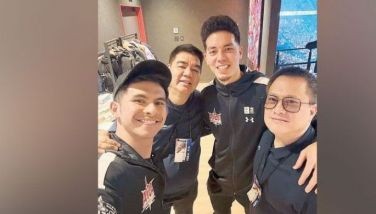Thoughts on 30 years
The Alaska Aces celebrated their 30th anniversary Thursday evening at a grand, entertaining, heart-warming ceremony, one that brought home former players from other teams and around the globe. As always, the Aces celebrated in style. The anniversary also triggered a lot of memories for this writer, who entered the profession in the same year, 1986. Zipping back through three decades of memories can be dizzying, like trying to swallow a huge slice of rich chocolate cake in record time – I don’t know how professional eaters do it.
Kidding aside, 1986 was such a different world then. Our class was a month shy of graduating from college when the EDSA People Power broke out and changed the way the world looked at democracy. Of course, history has added depth and shade to that brightly colored kaleidoscope of events that led to heady months of peace, and a clean name and slate for Filipinos around the world. From Jane Fonda doing the “L” sign during the Oscar Awards to Americans hugging Filipinos in the middle of the streets of New York City, we felt pretty good about ourselves. And let’s leave it at that. The rest is for another story.
In 1986, the Alaska Milkmen entered the PBA, and San Miguel Beer took a leave of absence in the first two conferences, the only time the Beermen have not played in the league since 1975. Alaska joined with a mix of veterans and new players, and San Miguel Beer returned with the bulk of the Northern Cement team that had won the Jones Cup at the expense of the US. Allan Caidic had stayed behind with the national team, was taken by Great Taste, and only returned to his original mates after six years. It was a time full of hope, promise, and new beginnings. Those of us who were starting our careers then literally felt we could do anything. But looking back, you don’t need a revolution to make you feel that way.
1986. No flyovers zipping you along EDSA. No MMDA doing the opposite. Fewer vehicles, fewer buses, fewer people. Sports in the country was then run with utmost efficiency by Michael Keon, who was in a great position being both president of the Philippine Olympic Committee and head of Project: Gintong Alay, the precursor of the Philippine Sports Commission. The PSC would come to life in 1990, the fruit of a laborious battle by then Sen. Joey Lina to streamline and upgrade Philippine sports. In the intervening years, the country has hosted the World Chess Olympiad and the Southeast Asian Games twice (1991 and 2005). But in 1986, those were all not even pipe dreams.
What was around in 1986 that is still there today? It was the transition period from the first batch of PBA legends to the second generation of Samboy Lim, Alvin Patrimonio, Benjie Paras and their kind, players who had been fortunate enough to be at the cusp of newborn techniques in training that boosted their success in amateur competition. It was immediately after San Sebastian College’s dominance of the NCAA and other collegiate tournaments, on a team that produced Bong Alvarez and an entire roster that made it to the PBA, save for their coach, Francis Rodriguez. Now there’s an irony if ever there was one. San Beda College was going through a drought then, despite the departure of old rival Ateneo de Manila University to the younger UAAP.
And speaking of the Blue Eagles, their rivalry with De La Salle University was lit ablaze with the Green Archers’ jumping the fence in 1986. The two had not clashed in a basketball final since 1974. That tradition returned in 1988, and their blazing duels have been sports headlines ever since, five years before the experimentation with a Final Four format. Frankly, the separation of eras has given birth to a lot of myths and apocryphal stories, and bears deeper study. Even the longest-standing, staunchest alumni boosters on both sides have their own versions of how it all began. We would have to resurrect a few of the deceased cheerleaders and players to get a clearer picture. And even then, they would probably still argue with each other.
Sadly, the athletes of that era are no longer thrilling us with their exploits. With what is called the Golden Age of Philippine athletics, we saw the rise of Lydia de Vega, Isidro del Prado and their generation, who took not just Southeast Asia but the continent by storm. Injured or ill, they suited up. That was also when we discovered the creative magic of Bata Reyes. He proved himself in every facet of the game, even venturing into snooker in the early 1990’s, and even beating the world champion in tournament play without even knowing it. Thankfully, he’s still around, still giving his opposition lessons in imagination. How much the poorer the sports world would be if he ever decides to retire. A little later, we would have Christine Jacob and Bea Lucero, indomitable in each of their fields, and an inspiration to young girls like Diay was, as well. Those were great times to be a sports journalist. Stories of their successes seemingly fell out of the sky with regularity, making my job easier.
But there is one more, another giant who still looms large not only over his sports, but all sports. Ageless Paeng Nepomuceno. Who would have thought that, more than two decades after 1986, he would tally three Guinness world records and be a main attraction in bowling’s Hall of Fame? Think about it: Paeng was already winning when Flash Elorde was still alive (he died in 1985), and is still at the top of the bowling certifying coaches and adding to his warehouse full of hardware as Manny Pacquiao is on the eve of retirement. Seriously, think about that for a moment. And people thought I was crazy for saying he is the greatest Filipino athlete of all time. But I digress.
1986 was years before open basketball, before the port would start a steep evolutionary climb, before the pros of Europe who played on their national teams would inspire Filipino professionals – and a few months later, the Americans – to do the same. 1986 was when media freedom turned into an explosion. Dozens of newspapers opened, and old ones reopened. Radio stations were everywhere, and networks like ABS-CBN were restored to their rightful owners. That giant leap in communications also set the long, slow process for sports to become a staple on television, especially when the PBA hit its peak in 1989.
And all that is just the tip of the iceberg. As Jose Rizal says, if we don’t look back where we’ve been, we’ll never get to where we’re going.
- Latest
- Trending


























